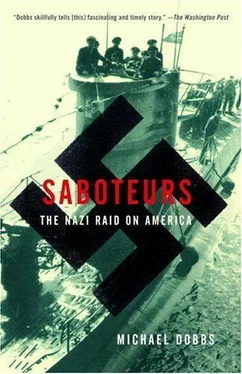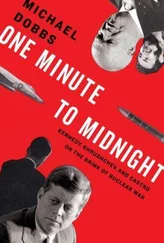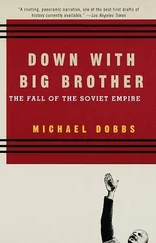Kappe, Burger learned, was a former editor of German-language newspapers in Chicago and New York. He had also been a high official in the German-American Bund. Some of the other men at the camp had heard Kappe speak at meetings in Chicago, railing against the Jews and urging his audience to show solidarity with the “New Germany.” Fat and jovial, with an eye for the ladies, Kappe was not the kind of man you easily forgot. His flabby face was very distinctive, “a real baby face.” 13According to an unflattering portrait in the files of the American FBI, he spoke English with a strong German accent, which he tried to hide “under an atrocious and unsuccessfully affected phony Oxford accent… Kappe likes to play the suave, imperturbable superman but can easily be made to lose his cool.”
Kappe had personally screened all the men selected for training at the sabotage school, and had arranged their transfers to Quenz Lake. In Burger’s case, Kappe had questioned him extensively about his experiences in the United States. Satisfied with his answers, Kappe made arrangements for Burger to be transferred from guarding a prison camp outside Berlin to a secret military unit known as the Lehrregiment that trained espionage and sabotage agents for the German High Command. The Brandenburg garrison, where Burger was ordered to report en route to Quenz Lake, was an outpost of the Lehrregiment.
Burger arrived at the farm on Saturday, April 11. Since classes were not scheduled to begin until Monday, he devoted the rest of the weekend to getting to know his fellow trainees. They spent much of Sunday lounging around the living room of the main farmhouse, perusing various American newspapers and magazines long banned in Germany, such as the New York Times, Life, and the Saturday Evening Post. The publications, most of which were about two months old, were stamped “Property of OKW, to be returned.” 14OKW, Burger knew, stood for Oberkommando der Wehrmacht, the German High Command. There were also reading materials in Hindi, Arabic, and various other languages.
The other trainees were all German-Americans who had spent varying amounts of time in the United States. Some spoke good English; others retained a thick German accent. Most had worked in menial occupations in America, such as cook, housepainter, chauffeur, odd-job man. They ranged in age from early twenties to mid-forties.
Dasch turned out to be a character, thirty-nine years old, very loquacious, and full of nervous energy. Before returning to Germany in May 1941, he had spent nearly twenty years in America, where he held a variety of jobs, including waiter, traveling salesman, and manager of a brothel. His English was a little rusty, but he had an extraordinary command of American slang, and would sprinkle his conversation with expressions that seemed to be lifted out of a Boy’s Own magazine, such as “check and recheck,” “scram,” and “blow my stack.” He referred to his brain as his “noodle” and people he disliked as “a bunch of nuts.” Once he began to talk, it was difficult to get him to stop. Burger noticed that Dasch had the habit of waving his long, gangly arms while talking to people and holding his index finger up to his nose, as if to preempt anyone who might try to interrupt him. Dasch had been selected to lead a team of four or five saboteurs that would include Burger.
The leader of the second group was Edward Kerling, alias Eddie Kelly, a heavy-jawed man with thick wavy hair who always seemed to be smiling. Kerling dropped hints that he was a Nazi Party member of long standing, with a membership number of around 70000, indicating that he, like Burger, was one of Hitler’s early followers. 15He had lived in America for eleven years, and had had quite an adventure getting back to Germany. In 1939, after Hitler invaded Poland, Kerling and a few friends pooled their savings to buy a small yacht, the Lekala, with the intention of sailing across the Atlantic and offering their services to the Fatherland. But the boat was intercepted by the U.S. Coast Guard, triggering a spate of newspaper headlines about American Nazis making illegal trips to Germany and violating the Neutrality Act. The following year Kerling managed to get his papers in order, and returned home on board a regular ship.
The “life of the party,” Burger concluded early on, was Herbie Haupt, muscular, darkly handsome, nearly six feet tall, an accomplished concertina player “with classical Greek features.” 16Haupt was the youngest person selected for the school—he was twenty-two—and also the most Americanized. He had lived in Chicago from the age of five, growing up in the ethnic German neighborhoods of the North Side and becoming a naturalized American citizen. He spoke English better than he spoke German. Haupt’s main interests, it soon became clear, were money and girls. He entertained the other trainees with stories of reaching Germany via Mexico and Japan, rounding Cape Horn and running the British blockade along France’s Atlantic coast, a feat for which he had been awarded the Iron Cross, Second Class.
Haupt spent much of his time with a blue-eyed, blond-haired giant named Joseph Schmidt, a reserved man with a high-pitched voice and a Swedish accent. Schmidt was very strong, impressing the others with his trick of bending metal bars. His background was a little mysterious. He was an excellent shot and outdoorsman; it seemed he had worked in Canada as a hunter and trapper. Burger understood that he had become acquainted with Haupt in Mexico, and had traveled to Europe with him on the same blockade-runner. Along with a natural reticence, Schmidt had a hot temper, and was liable to fly off the handle when contradicted. Of all the trainees, Burger considered him “the most dangerous.” 17
Then there was a stocky little man whom Burger knew only as Dempsey, who amused the others with stories about his career in the United States as a professional boxer and trainer of prizefighters. Burger noticed that he spoke out of the corner of his mouth like a gangster, and that most of his front teeth were missing, suggesting that he had been bashed about a bit in his time. 18Dempsey served as the men’s first physical education instructor. Kappe wanted him to join the sabotage mission, but he pleaded a prior commitment: one of his boxers was fighting a big match against an Italian. He left Quenz Lake after a few days with a cheery goodbye and a promise to “follow you guys” to America. 19
The remaining trainees made less of an impression on Burger. Richard Quirin and Heinrich Heinck had both worked for Volkswagen and appeared to be inseparable. Quirin had large protruding ears and walked with a forward slouch; Heinck was a “slow-moving phlegmatic type,” who seemed “not quite sure of himself.” 20Hermann Neubauer, “a typical gangster type,” always wore “a hat pulled down on his eyes exactly straight.” Werner Thiel was a “shabby dresser” who spoke in a slow monotone. Ernst Zuber, a high-strung man with a round face, was unable to express himself clearly, in either English or German. The last member of the group was a wiry little man with large eyebrows, known to everyone as Scottie because he looked and acted like a Scotsman.
All in all, they were a mediocre lot.
AT NINE o’clock on Monday morning, after everyone had finished breakfast and calisthenics, Kappe summoned the trainees to the classroom above the garage. They sat down in front of him on rows of school benches like a bunch of eager pupils, pens and notebooks ready, watching him pace back and forth across the wooden floor. Stopping production in America, he told them, was as essential to the German war effort as the battles raging on the Russian front. 21It would be their job to sabotage the American light metal industry and the transportation system along the East Coast. This was the first time most of them had heard the word “sabotage” mentioned in connection with their mission.
Читать дальше












